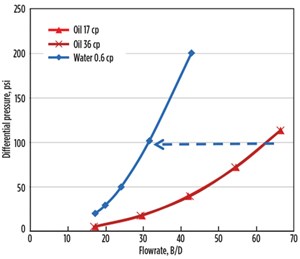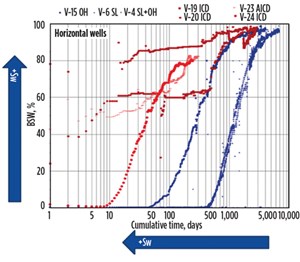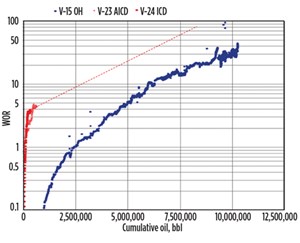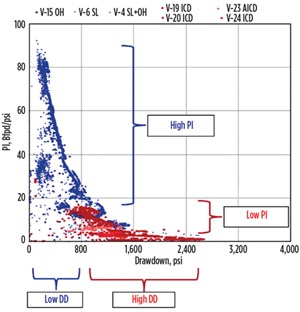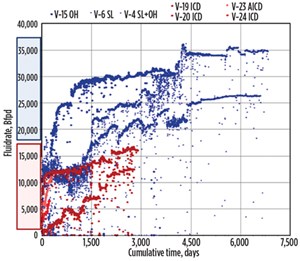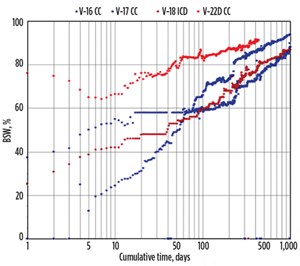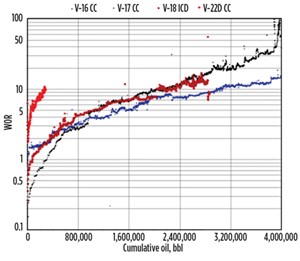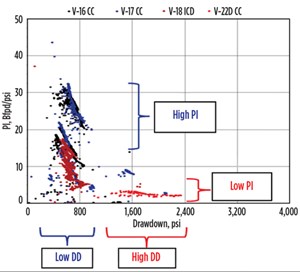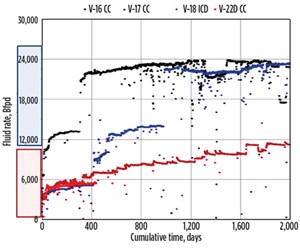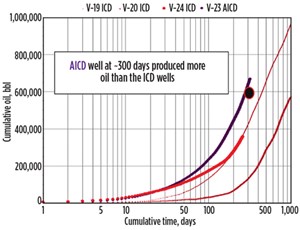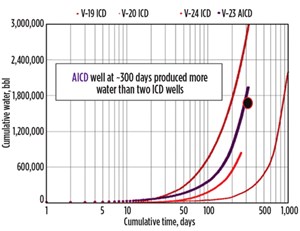Completion design analysis: A case study for water control in Villano field, Ecuador
Agip Oil Ecuador (AOE) operates Villano field, in a tropical rainforest in Pastaza Province of Ecuador. The field was discovered in 1950 by Shell Global. Production began in May 1999. Since 2000, the field has been operated 100% by AOE. The development was completed in six phases, which included the construction of facilities, flowlines and well pads, and the drilling of production and water disposal wells (WDW). The field produces approximately 12,900 bopd and 204,000 bwpd, which is 100% re-injected. The water disposal is in the Hollin formation, below the oil-water contact. The producing wells are horizontal with 1,500 to 2,500 ft of open-hole length. However, oil production is constrained by the maximum fluid handling capacity.
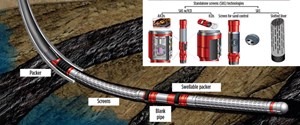
COMPLETION DESIGN
To help alleviate water issues, completion designs have evolved from conventional open-hole/slotted-liner configurations, to incorporating inflow control devices (ICD) and autonomous inflow control devices (AICD), to control water production. To optimize ICD/AICD designs, engineers perform work in three phases: 1) conceptual design; 2) detailed design; and 3) procurement. The primary function of a completion is to produce hydrocarbons to the surface or deliver injection fluids to formations. However, the new completions also need to satisfy HSE and optimize production, while enabling pressure monitoring and reservoir maintenance.
Most of the Villano field wells are horizontal and the completion designs have been evolving from openhole and with slotted liners to water-control solutions, such as ICDs and AICDs. The primary reservoir factors influencing completion design that were considered included the producing zone’s isolation distance from fluid contact, secondary targets, minimum zone separation and interval length.
WATER CONTROL COMPLETIONS
Nozzle-based ICD. The viscosity differences between oil and water in Villano field create an unfavorable mobility ratio, where the water flows at a higher velocity than the oil. Any method to delay and stabilize the water in the well can assist in optimizing oil production. ICDs were evaluated for this purpose. The short technology screening process concluded that the most appropriate technology was a “passive” nozzle-based ICD. Other available technologies, which included channels or tubes, created pressure drops by shearing the fluid, making the pressure drop dependent on fluid viscosity, which resulted in choking back the oil. The pressure drop through the nozzle is a result of the static energy being converted to kinetic energy and absorbed in the fluid downstream of the nozzle.
Influx differences from the reservoir can result in premature water or gas breakthrough, leaving valuable reserves in the ground. ICDs are designed to improve completion performance and efficiency by balancing inflow throughout the length of a completion. Placement of these ICDs is typically incorporated into the design phase of a project and adjusted with MWD/LWD data. The ICD is a nozzle-type configuration offering adjustability that can be pre-set to a wide range of specific requirements before installation, without the use of specialty tools. However, once downhole, the ICD settings for flow restriction remain fixed.
Autonomous inflow control device. Fluidic-diode AICDs autonomously adjust the pressure drop and flowrate through the device, based on downhole fluid properties. These types of devices are more effective than ICDs in optimizing oil production, and for restricting water and gas production. The AICDs utilized at Villano use fluidic technology, engineered as flow path channels to direct the fluid autonomously through a low- or high-resistance path. They function similar to ICDs during oil output, while restricting the production of water and gas upon breakthrough to minimize water and gas cuts. The AICD in well Villano-23H has no moving parts, requires no downhole orientation, and adjusts its flowrate, based on the properties of the downhole fluids.
The AICD contains two fluid dynamic components, a viscosity selector and a flow restrictor, both of which function together to allow or restrict the flow of fluid without moving parts. The viscosity selector uses a system of channels that, based primarily on fluid viscosity, identifies the fluid that is flowing through the AICD and then directs how the flowstream enters the flow restrictor. The higher-viscosity fluid (oil) takes a direct, radial pathway to the exit, while the less-viscous fluid (water and/or gas) takes a tangential pathway to the exit, Fig. 1. Based on the viscosity selector’s output, the flow restrictor significantly increases the restriction of the unwanted fluid (water and/or gas) while providing minimal restriction to the production of the desired fluid (oil). The increased flow restriction for water is gradual, as the ratio of this fluid increases.
Flow tests were used to measure the performance of the AICD at representative downhole conditions. Figure 2 shows single-flow performance testing through a single insert, using Calpar 150 oil to achieve 17 cp (122°F) and 36 cp (93°F) and water at 112°F for 0.6 cp viscosity. The graph illustrates that the fluidic-diode AICD produces oil at a greater flowrate than water at the same differential pressure. Oil at 17 and 36 cp is produced at similar flowrates through the device. However, when water flows through the AICD, comparing at a 100-psi pressure differential, the flowrate is reduced approximately 48%. The restriction of the fluidic-diode AICD is reversible.
PRODUCTION DATA ANALYSIS
In Villano, 65% of the wells used for production data analysis are horizontal. Water-control technologies have been implemented since 2010. The following comparative analysis describes the differences between conventional open-hole/slotted liner, versus ICD and AICD completions, in terms of water cut (WC), water/oil ratio (WOI), productivity index (PI), drawdown (DD), and fluid rates. Horizontal and deviated wells were separated to provide a better comparison.
Horizontal wells. Because of the strong water drive mechanism, it can be assumed that water saturation into the reservoir during the productive life of the field will increase. Figure 3 shows the anticipated time to water breakthrough: 500 days for the wells drilled and completed from 1999 to 2000, and 10 days for the last well drilled in 2017. The wells did not initially start with 0% WC; currently, it is common that most wells begin with a basic sediment and water (BS&W) greater than 60%. Even with such a scenario, the plot shows that the water-control wells (in red) have a different trend, compared with open-hole and slotted-liner wells (in blue). This means the mechanisms installed (ICD/AICD) are changing the normal production behavior of this type of reservoir; even the Kv/Kh is almost ~1.
Figure 4 shows the WOR versus cumulative oil trend, which is the basis for reserves estimation. The water-control mechanisms are not detrimental to reserves; in some cases, they maintain the reserves, and other times the reserves increase with time. Figure 5 shows the effect of water control on the well behavior. A clear difference can be observed in the PI and DD of the open-hole and slotted-liner wells versus the ICD/AICD wells. The water-control wells have, from the onset, created an additional mechanical skin to the well. This “good skin” helps prevent and delay the water influx. For this reason, these types of wells have less productivity and require more DD to produce the desired fluid targets. In Villano field, the open-hole and slotted-liner wells typically produce rates greater than 20,000 to 30,000 bfpd. The water-control wells have maximum rate values of approximately 15,000 bfpd, Fig. 6. In most fields, water production represents a bottleneck. As such, the completion strategy in the Villano field changed from conventional slotted liner completion to ICD/AICD. The lower rates allow the capability to manage the actual total production rates in an efficient manner.
Deviated wells. As previously discussed, ICDs are used primarily to reduce the heel-toe effect in horizontal wells, which delays water breakthrough. For deviated wells, the ICDs also delay early water breakthrough. Additionally, it is important to consider that the ICD completion selection for a 66° deviated well is adequate, because the quality of the initial casing cementation is uncertain for a well with greater than 45° inclination. Figure 7 shows the BS&W versus normalized time. The water-control wells (in red) show a better trend than the analogous casing and cemented wells. Figure 8 shows the effect on the reserves. Well V-18 ICD, with almost 3 MMbbl of production, has a better trend compared to the analogous well V-22D AICD, which is not performing as expected, resulting from issues during the installation phase of the device. This emphasizes that achieving production targets requires a well-defined procedure for running in-hole devices. After analysis, a high skin (out of normal range) was detected in these wells, mostly related to screen plugging in the upper AICD completion compartments.
Figure 9 shows the low PI for Well V-22D, which performed differently than the ICD and perforated wells in terms of fluid production. Figure 10 shows the production difference between a deviated well, with and without water-control mechanisms. Water-control wells were in the range of 6,000 bfpd, while conventional wells produced at rates from 12,000 to 24,000 bfpd.
ICD vs AICD
The first part of the analysis focused on horizontal wells, comparing the cumulative rates. While the AICD well (V-23HST2) produced 50% (from 400,000 bbl to 600,000 bbl) to 500% (from 100,000 bbl to 600,000 bbl) more oil, comparatively, at 300 days (Fig. 11), it also produced water because of the higher total fluid volume (Fig. 12). The higher total PI might not necessarily represent the best producer, because it combines oil and water production, but it is needed to evaluate the percentage of water cut with regards to oil production. In this scenario, the best key performance indicator to use for comparing both technologies are to separate the PI into oil PI and water PI, and to plot a ratio between the BS&W versus the oil PI. The well having the higher oil PI, with the lowest WC would represent the best producer.
For the horizontal wells, the AICD wells performed better than ICD completions. However, for the deviated wells, the ICD completions performed better, which could be related to the high skin and poor operational practices, such as inadequate well cleanup and fluid conditioning during RIH, leading to screen plugging in the upper section of the V-22D well.
LESSONS LEARNED
The water-control completion using AICD/ICD technology provided significant benefits during the field development, allowing well production with a low water PI and high oil PI. Because the fluid handling capability is a concern in Villano field, this technology helped optimize energy use by producing wells with low fluid rates and good oil performance.
AICD completions performed better than ICD completions in horizontal wells; however, performance in deviated wells was not as expected, because of operational issues experienced during the installation phase.
Emphasizing the input data (permeability and water saturation) during the design phase is the most important factor for achieving a match with the actual well conditions. WO
Acknowledgment
This article is an abridged version of SPE paper 191635, presented at the SPE ATCE held in Dallas, Texas, Sept. 24–26, 2018.
- Water management (February 2024)
- Executive viewpoint (November 2023)
- Offshore potable water production from subsea karstic aquifers (November 2023)
- Singlet oxygen-generating treatment technology achieves sustainable operations, helps operators meet production goals (November 2023)
- Water management (October 2023)
- Water management (August 2023)
- Applying ultra-deep LWD resistivity technology successfully in a SAGD operation (May 2019)
- Adoption of wireless intelligent completions advances (May 2019)
- Majors double down as takeaway crunch eases (April 2019)
- What’s new in well logging and formation evaluation (April 2019)
- Qualification of a 20,000-psi subsea BOP: A collaborative approach (February 2019)
- ConocoPhillips’ Greg Leveille sees rapid trajectory of technical advancement continuing (February 2019)


